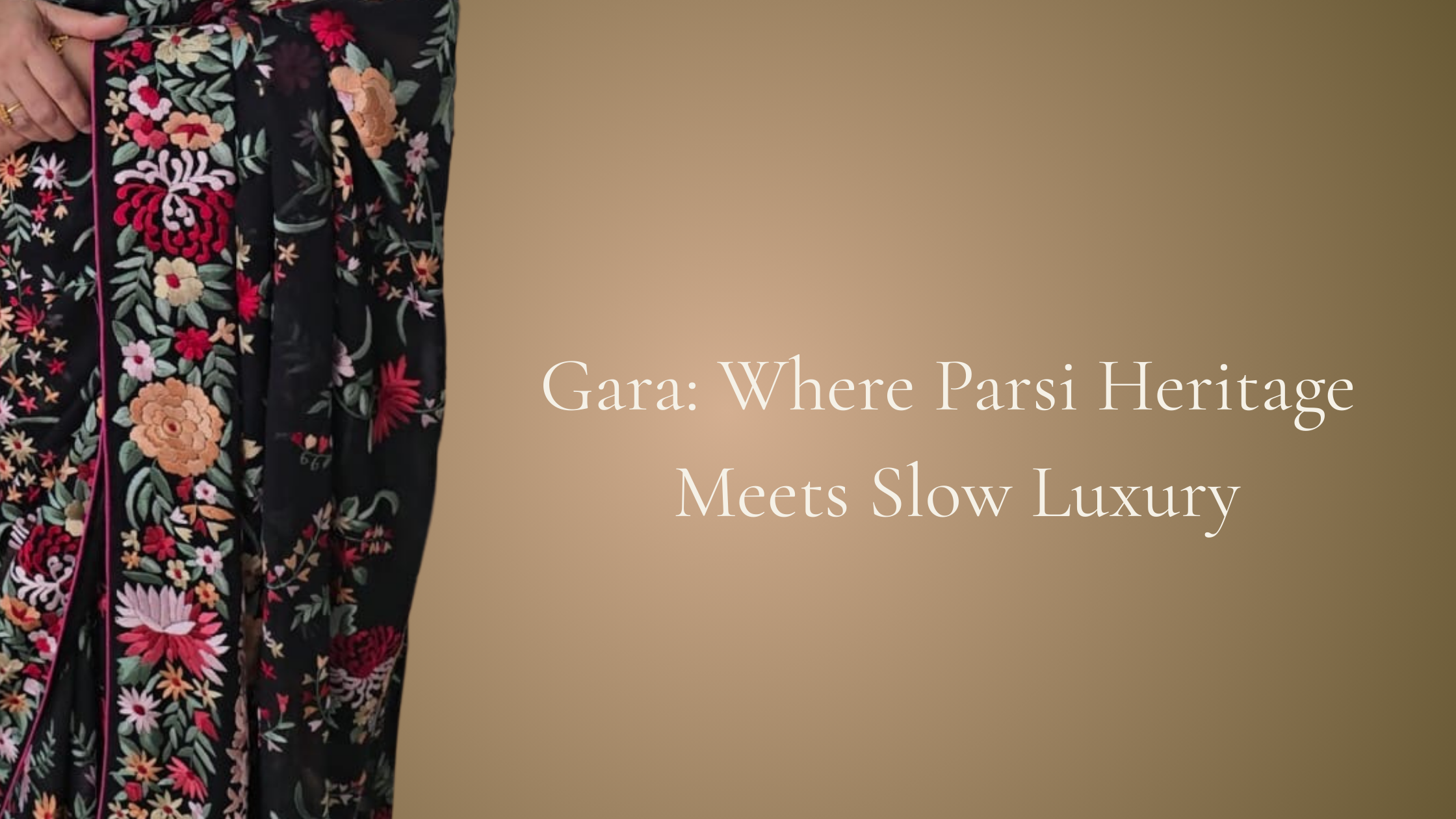Stitched Through Centuries: Persian Gara and the Legacy of Threaded Storytelling
In a quiet corner of an heirloom trunk, wrapped in soft muslin and time, lies a sari embroidered with silken vines, celestial birds, and dancing dragons. To the untrained eye, it's exquisite. To those who know, it’s sacred. This is Persian Gara—a textile tradition carried across continents, stitched by hand, and worn with reverence. It is not just a garment. It is legacy, identity, and slow luxury woven into fabric.
From Persia to Gujarat: A Textile Odyssey
Gara embroidery finds its roots in ancient Persia but was shaped and sanctified in India by the Parsi community—Zoroastrians who fled Iran and settled in Gujarat centuries ago. With them came Persian aesthetics, which blended seamlessly with Chinese silk influences and Indian craftsmanship.
By the 19th century, the Parsi Gara sari had become a symbol of feminine elegance within the community, worn at weddings and rites of passage. Merchants would bring back Chinese silk embroidered with mythical creatures, chrysanthemums, and pagodas. Indian artisans adapted the motifs using the intricate aari stitch, developing a style that was uniquely theirs.
Every Stitch a Symbol
Gara embroidery is dense with symbolism.
Cranes and peacocks: grace and immortality
Chrysanthemums: longevity and celebration
Dragons: strength and divine power
Vine creepers: eternity and continuity
While flora and fauna are common, Gara designs often feature intricate scenes that reflect the cultural interplay between Persia, China, and India during the height of the Parsi trading era. Some notable examples include:
Chinese courtly figures: Often depicted mid-conversation or in elegant poses, these figures symbolize harmony, scholarship, and the Parsi community’s historical trade ties with China.
Birds in pairs: Such as kingfishers and magpies—symbols of love, fidelity, and auspiciousness.
Pagodas and bridges: Scenic elements that reflect Chinese landscape art, conveying peace and balance.
Butterflies: Common in Chinese symbolism, these represent joy and good fortune.
Pine trees and bamboo: Signifying resilience, longevity, and integrity—often paired with cranes in dreamlike settings.
Each motif is more than decorative; it tells a story, often referencing moral virtues, cosmology, or community aspirations. It’s this narrative richness that elevates Gara embroidery into the realm of living textile archives.
Each Gara sari could take 6–12 months to complete, depending on complexity. Using fine silk threads on georgette or satin, artisans—often working from memory—stitched elaborate, flowing compositions with a painter’s intuition.
Silent Artisans, Loud Legacies
Historically, these embroideries were crafted by women within the community and local artisans trained by Parsi matriarchs. It was both art and ritual—passed down through generations. Gara was more than occasion-wear; it was part of a bride’s trousseau, a family’s archive, a daughter’s inheritance.
Among the earliest revivalists, Zenobia Davar stands out for her pioneering work in restoring authentic gara embroidery. Her research, restoration of vintage pieces, and educational efforts have brought renewed respect and visibility to the craft. Davar’s role in codifying and documenting original motifs helped preserve a near-forgotten language of stitch.
The New Vanguard
In recent years, Ashdeen Lilaowala has reintroduced Gara to the global stage. His eponymous label honors traditional motifs while adapting the embroidery into wearable silhouettes—jackets, kaftans, scarves—that resonate with modern luxury seekers.
"We're not modernizing gara," Ashdeen says, "we’re recontextualizing it."
His atelier, based in New Delhi, works with skilled artisans and keeps production intimate, transparent, and entirely hand-embroidered. Each collection is a love letter to heritage.
Other designers and collectors like Talking Threads, Meher Collections, are also curating vintage gara saris, preserving them as both cultural artifacts and fashion treasures.
Natasha Poonawalla, known for her bold, couture-infused global style, has also helped bring gara back into contemporary relevance by wearing embroidered pieces at high-profile fashion events. Her stylings including the recent MET Gala 2025 look by Manish Malhotra have introduced this textile tradition to international fashion circuits, making gara visible in elite, couture-centric conversations.
Indian designers such as Sabyasachi Mukherjee, Anamika Khanna, and Rahul Mishra have referenced gara-inspired motifs in their work—infusing bridalwear and occasionwear with dense, storytelling embroidery reminiscent of the tradition, while championing Indian craft on global runways.
How to Identify Authentic Gara
Fabric: Typically silk or georgette, heavy with embroidery
Motifs: Balanced, continuous storytelling in the design
Stitching: Hand-done, with even tension and fluid curves
Borders: Heavily worked pallu and pallav, often framed like a painting
True gara pieces are never rushed. They are tactile meditations.
Slow Luxury, By Inheritance
In the world of fast fashion, gara remains refreshingly unbothered. It isn’t seasonal. It isn’t trend-driven. And it never repeats itself. Each piece is unique, just like the woman who wears it.
The slow, sacred nature of gara makes it an exemplar of conscious luxury. It teaches us that style isn’t just about looking good—but knowing, remembering, and honoring what we wear.
Wearing Gara Today
You don't need a wedding to wear a piece of history. Gara embroidery today appears on:
Silk bomber jackets lined with floral creepers
Hand-embroidered dupattas over minimal separates
Framed panels as art in sustainable interiors
Even bridal veils and lehengas that blend cultures
Pair a vintage gara with a white shirt, or a gara tunic with linen trousers. Let the embroidery speak. It always does.
A Cultural Cloth of Continuity
To wear Persian gara is to wear a story older than borders. It’s a testament to global migration, feminine artistry, and the invisible threads that bind us across generations.
In every stitch, there is memory. In every motif, a message. In every piece, a quiet rebellion against disposability.
This is not just embroidery. It’s endurance, elegance, and ethics—all sewn into silk.


